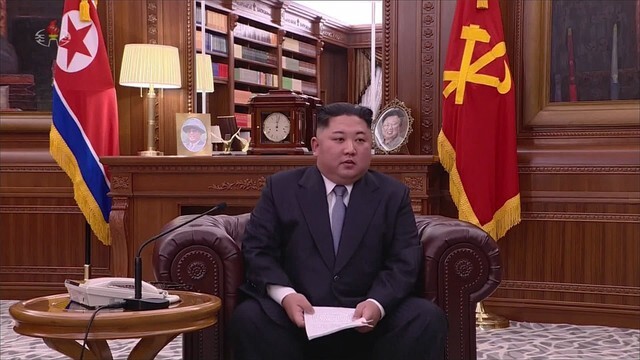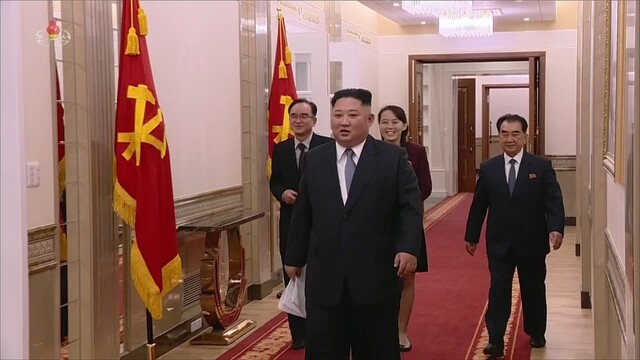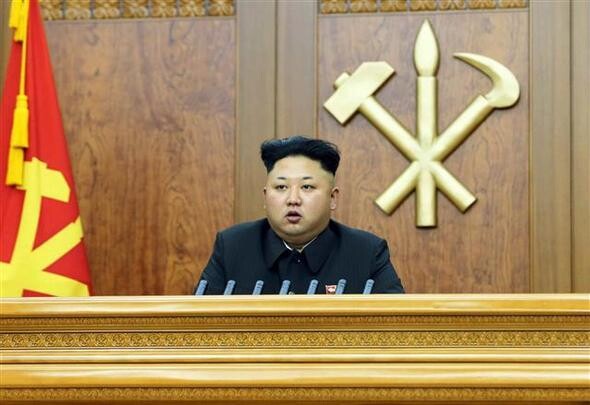hankyoreh
Links to other country sites 다른 나라 사이트 링크
Format of Kim Jong-un’s New Year’s address markedly deviates from past practices

North Korean leader Kim Jong-un adopted an unconventional format for his 2019 New Year’s address.
Dressed in a deep blue suit and necktie, Kim delivered the 30-minute-long address on Jan. 1 from a one-person sofa in his office at the Workers’ Party of Korea (WPK) Central Committee headquarters in downtown Pyongyang. In a marked contrast with his practice in past years of standing on a platform and delivering the address as though giving a speech, his approach this year was comfortable and conversational. Also absent were blunt references to the “nuclear button,” “imperialist invaders,” and “stratagems to provoke war” he has commonly employed in the past.
Airing the recorded address at 9 am that day, the Korean Central Television (KCTV) network first showed a smiling Kim walking down the hallways and stairs toward his office with State Affairs Commission Chief Secretary Kim Chang-son, WPK First Vice Director Kim Yo-jong, and WPK Organization and Guidance Department Vice Director Cho Yong-won. In Kim Jong-un’s office, large photographs of past leaders Kim Il-sung and Kim Jong-il hung on one wall, while another wall was filled with books and documents as in a study.
While last year’s address was broadcast by North Korea at 9:30 am South Korean time (9 am in Pyongyang), this year’s was shown at 9 am in South Korea following the May 5 re-integration of South and North Korean standard time in the wake of the inter-Korean summit at Panmunjom.

The changes in the New Year’s address appeared designed to underscore the image of North Korea as a sophisticated, normal state. Moon Chung-in, special presidential advisor for unification, foreign affairs and national security, described the address as “corresponding to international standards.”
“What stands out is the format, where [Kim] is sitting on a sofa as though having a conversation with the public, rather than the stiff and high-handed approach seen in the past,” Moon noted.
Kim dedicated over 60% of the address to messages for North Koreans on areas including economic development.
Kim named a “self-sufficient socialist economy” as a slogan, mentioning it a total of seven times and calling for the “opening of a new path of advancement for socialist construction under the banner of autonomous renewal.”
The message proposed an economic development approach based on full use of domestic resources amid ongoing sanctions by the international community.
At the same time, Kim also emphasized the pursuit of economic reforms. Announcing plans to “reform management methods to allow workers to display their individual passion and creative abilities to the fullest,” he stressed the importance of “reorganizing institutional and business systems to increase the efficiency of economic efforts and allow companies to proceed smoothly with their business activities.”
University of North Korean Studies professor Yang Moo-jin noted, “Under the Kim Jong-un regime, North Korea has made considerable achievements with ‘North Korean-style economic management’ reforms, including the adoption of a family agriculture model at cooperative farms and stronger autonomous rights for small businesses.”
“The message he sent called for building on these results and continuing on with economic reforms, while making advance preparations for reforms and openness as denuclearization progresses,” he said.

As chief areas of construction, Kim made reference to building in Samjiyon County and the Wonsan-Kalma coastal tourism area, where tourism zones are currently being developed. In another noteworthy message, he referred to role of the munitions industry in “ensuring peace” and called for its “active support in building the economy.”
By Park Min-hee and Noh Ji-won, staff reporters
Please direct comments or questions to [english@hani.co.kr]

Editorial・opinion
![[Column] Has Korea, too, crossed the Rubicon on China? [Column] Has Korea, too, crossed the Rubicon on China?](https://flexible.img.hani.co.kr/flexible/normal/500/300/imgdb/original/2024/0419/9317135153409185.jpg) [Column] Has Korea, too, crossed the Rubicon on China?
[Column] Has Korea, too, crossed the Rubicon on China?![[Correspondent’s column] In Japan’s alliance with US, echoes of its past alliances with UK [Correspondent’s column] In Japan’s alliance with US, echoes of its past alliances with UK](https://flexible.img.hani.co.kr/flexible/normal/500/300/imgdb/original/2024/0419/2317135166563519.jpg) [Correspondent’s column] In Japan’s alliance with US, echoes of its past alliances with UK
[Correspondent’s column] In Japan’s alliance with US, echoes of its past alliances with UK- [Editorial] Does Yoon think the Korean public is wrong?
- [Editorial] As it bolsters its alliance with US, Japan must be accountable for past
- [Guest essay] Amending the Constitution is Yoon’s key to leaving office in public’s good graces
- [Editorial] 10 years on, lessons of Sewol tragedy must never be forgotten
- [Column] A death blow to Korea’s prosecutor politics
- [Correspondent’s column] The US and the end of Japanese pacifism
- [Guest essay] How Korea turned its trainee doctors into monsters
- [Guest essay] As someone who helped forge Seoul-Moscow ties, their status today troubles me
Most viewed articles
- 1[Column] The clock is ticking for Korea’s first lady
- 2After 2 months of delayed, denied medical care, Koreans worry worst may be yet to come
- 3[Column] Has Korea, too, crossed the Rubicon on China?
- 4[Editorial] When the choice is kids or career, Korea will never overcome birth rate woes
- 5[Correspondent’s column] In Japan’s alliance with US, echoes of its past alliances with UK
- 6Hong Se-hwa, voice for tolerance whose memoir of exile touched a chord, dies at 76
- 7US exploring options for monitoring N. Korean sanctions beyond UN, says envoy
- 8Samsung barricades office as unionized workers strike for better conditions
- 9US overtakes China as Korea’s top export market, prompting trade sanction jitters
- 10[Photo] Smile ambassador, you’re on camera